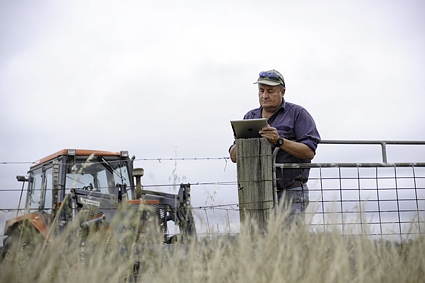Mobile technology is giving land managers instant access to localised soil information (Photo courtesy of CSIRO)
This month we’re pleased to hear from Claire Harris at our partner organisation CSIRO, about a new tool for accessing soil information
Thanks to a combination of better information, new ‘packaging’ and learning opportunities, a new community of soil information users are out there – and they may be visiting a farm near you.
You may have heard about SoilMapp for iPad? It accesses national soil databases to provide the best available soil information, part of the focus of TERN’s Soil and Landscape Grid.
The app, which was developed by CSIRO working through the Australian Collaborative Land Evaluation Program (ACLEP) and the Grains Research and Development Corporation (GRDC), is attracting attention far and wide – it has been downloaded 2,200 times.
According to Mr Bill Long, an agricultural consultant from South Australia, the app was developed with agricultural advisers to deliver what they needed on the ground.
‘While many advisers are aware of national databases we often won’t use them. We want something local – we are interested in our patch, our region,’ Bill says.
‘Advisers want to get simple information quickly and easily, to develop rules of thumb that help farmers make better decisions. So, building on the traditional “ute guide” idea, we wanted a small guide to the range of soil types that existed around the state that others had used to run decision support tools like Yield Prophet. Rather than use paper-based products we wanted to get with new technology as we are now accessing so much information in the field with iPads and tablets.’
Bill says that information from databases, mapping projects and tools like SoilMapp should be considered as part of learning and dialogue processes, not the be-all and end-all.
‘To change management on the ground we need to look not just at building knowledge but also behaviour, attitudes, and skills. We need to help advisers better understand soil and water management and learn from each other so they can then better advise their clients,’ he says.
Understanding and confidence in soil knowledge is growing in Bill’s region. This is facilitated, in part, through a group of 20 advisers getting together twice a year. They learn more about soil and water management through workshops, characterising soil through sampling or using soil probes and checking out the latest soil data for their region.
‘We can get the iPad out in the field, look up characterised soils in the region, and can tell that we’ve got a bit of salt down the profile that might limit access to water. Or we have a light clay that can hold up to 110 mm of water when the profile is full. So then we know that if we get a good, wet winter this will give us a buffer for spring and we can make appropriate fertiliser and fungicide decisions,’ Bill says.
‘Of course, farmers have intuitively known their fields were half-full, but now they have more exact, reliable information because they are able to have a dialogue with their advisers, who are more articulate on soil-water issues. As a result knowledge on the influence of stored soil water at a range of growth stages has improved significantly and farmers are making better management decisions.’
Published in TERN e-Newsletter April 2013







